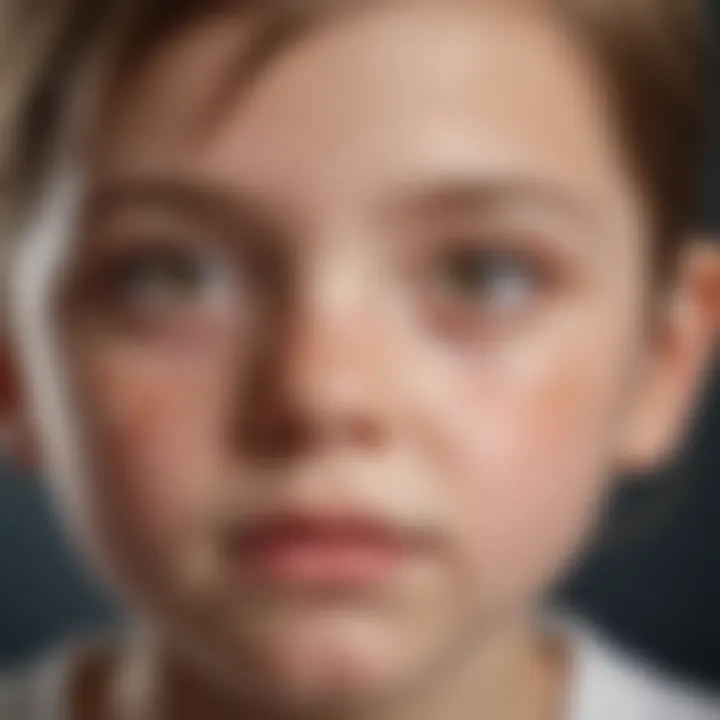Comprehensive Treatment of Allergic Conjunctivitis in Kids


Intro
Allergic conjunctivitis is a significant concern in pediatric health, affecting young children and their quality of life. Understanding its origins, symptoms, and treatment options is crucial for healthcare providers and caregivers. This article aims to provide an in-depth look at the factors associated with allergic conjunctivitis in children, focusing on both allergic mechanisms and therapeutic strategies.
Research Highlights
Overview of Key Findings
Recent research emphasizes that allergic conjunctivitis in children is primarily initiated by exposure to common allergens such as pollen, dust mites, and pet dander. The clinical presentation of the disease typically includes redness, itching, and tearing. These symptoms can significantly impact a child's daily activities and overall well-being. The interaction between environmental factors and the immune system plays a crucial role in the pathophysiology of this condition.
Significance of the Research
Recognizing the significance of allergic conjunctivitis in the pediatric population is essential. The prevalence of this condition has increased in recent years, highlighting the need for effective treatment approaches. Furthermore, the ongoing advancements in research provide new insights into the development of innovative therapies, which can enhance the management and treatment plans for young patients.
Current Treatment Approaches
In managing allergic conjunctivitis, various treatment modalities are employed. These can broadly be categorized into non-pharmacological and pharmacological remedies.
- Non-Pharmacological Treatments:
- Pharmacological Treatments:
- Avoidance of allergens
- Environmental modifications, such as using air purifiers
- Implementing good hygiene practices
- Antihistamines (e.g., cetirizine, loratadine)
- Mast cell stabilizers (e.g., cromolyn sodium)
- Topical corticosteroids (for severe cases)
Each treatment should be tailored to the child's specific needs, taking into consideration their overall health and the severity of symptoms.
"The effective management of allergic conjunctivitis requires a comprehensive understanding of both the symptoms and the underlying allergens that trigger them."
This guide will explore the specific treatments further, providing details on dosage, efficacy, and any potential side effects.
Importance of Research and Guidelines
The article will analyze the latest research trends and clinical guidelines available for practitioners. By keeping clinicians informed, this ensures a more structured and effective approach to managing allergic conjunctivitis in pediatric patients. This platform will serve as a valuable resource for those dedicated to improving the health and well-being of children suffering from this condition.
Prelims to Allergic Conjunctivitis
Allergic conjunctivitis is a common condition in children that causes discomfort and can impede daily activities. Understanding this condition is vital for healthcare professionals. It aids in recognizing symptoms early and implementing effective treatment strategies. This understanding not only improves quality of life for affected children but also reduces the burden on healthcare resources.
Definition and Overview
Allergic conjunctivitis is an inflammation of the conjunctiva, triggered by allergens. The conjunctiva is a thin membrane covering the eye and eyelid. When allergens enter the eye, they can provoke an immune response. This results in symptoms such as redness, itching, swelling, and tearing. The two primary types of allergic conjunctivitis are seasonal and perennial. Seasonal allergic conjunctivitis appears during specific times of the year, usually due to pollen. Perennial allergic conjunctivitis is a year-round condition, often caused by dust mites, mold, or pet dander.
Epidemiology in Pediatric Populations
Epidemiological studies indicate a significant prevalence of allergic conjunctivitis among children. It is estimated that around 10-40% of children may experience symptoms at some point in their lives. The incidence varies by geographical location and environmental factors. For example, children living in cities might show higher rates due to increased exposure to urban allergens. Understanding the prevalence of this condition helps in early identification and management, reducing potential complications such as missed school days and reduced activities.
Pathophysiology of Allergic Conjunctivitis
Understanding the pathophysiology of allergic conjunctivitis is crucial to formulating effective treatment strategies and managing this condition in pediatric populations. The mechanisms involved in allergic conjunctivitis can inform healthcare providers about the underlying causes of symptoms and help tailor interventions to improve patient outcomes. It also allows for a more comprehensive approach in identifying triggers and implementing preventive measures, thus optimizing treatment and care for young patients.
Mechanisms of Allergic Response
The allergic response is primarily an immunological reaction. When the conjunctiva, the thin layer covering the eye, encounters an allergen, it triggers a series of events involving immune system cells. The process begins with sensitization:
- Allergen Exposure - Initial contact with allergens, such as pollen or pet dander, is crucial. The immune system recognizes these specific substances as harmful.
- IgE Antibody Production - Upon the first exposure, the body produces Immunoglobulin E (IgE) antibodies. These antibodies specifically target the identified allergens.
- Mast Cell Activation - When the allergen is reintroduced, the IgE antibodies bind to mast cells, which are abundant in the conjunctiva. This binding leads to the degranulation of mast cells, releasing various mediators.
These mediators, chiefly histamines, contribute to the symptoms associated with allergic conjunctivitis, such as redness, itching, and tearing. Understanding this response highlights the pathways which can be targeted in treatment.
Role of Histamines and Inflammatory Mediators


Histamines play a significant role in the inflammatory response seen in allergic conjunctivitis. When released, they cause blood vessels to dilate and increase permeability, leading to:
- Conjunctival Edema - Swelling of the conjunctiva due to increased fluid leakage.
- Itching and Irritation - Histamine stimulates nerve endings, resulting in sensations of discomfort.
- Increased Tear Production - This is a defensive response to wash away allergens.
Other key inflammatory mediators include leukotrienes and prostaglandins, which exacerbate the inflammatory process and contribute to the sustained symptoms of allergic conjunctivitis. Recognizing the roles of these mediators guides clinicians in selecting appropriate therapeutic agents that can inhibit these pathways, offering targeted relief to young patients suffering from allergic conjunctivitis.
Key Takeaway: The pathophysiology of allergic conjunctivitis encompasses a complex interplay of immune responses, which is critical in tailoring efficacious treatments for pediatric patients.
Common Allergens in Pediatric Allergic Conjunctivitis
Understanding the common allergens associated with allergic conjunctivitis in children is significant for both diagnosis and treatment. Identifying these allergens can help in the creation of effective management strategies, minimizing symptoms and improving the quality of life for pediatric patients. Allergens can trigger the immune response in sensitive individuals, which leads to inflammation and discomfort. Thus, knowing what common allergens to look for is critical for both clinicians and caregivers. This section explores environmental and food allergens that are particularly relevant for children.
Environmental Allergens
Environmental allergens are substances present in the surrounding environment that can provoke allergic responses in sensitive individuals. In pediatric populations, common environmental allergens include:
- Pollen: Grass, ragweed, and trees are frequent contributors to allergic reactions. Pollen levels can vary significantly with the seasons, which may exacerbate symptoms at certain times of the year.
- Dust mites: These microscopic organisms thrive in bedding, carpets, and upholstered furniture. Regular cleaning routines can help minimize their presence.
- Mold spores: Mold grows in damp environments and can release spores into the air. Areas with high humidity or standing water are more prone to mold growth.
- Animal dander: Proteins found in the skin flakes, saliva, and urine of furry pets can trigger allergies. It can be challenging, especially in homes with pets, to manage exposure.
These environmental allergens can lead to significant challenges in managing allergic conjunctivitis. Clinicians often suggest environmental control measures, such as air filters or HEPA vacuum cleaners, to reduce exposure for sensitive children.
"Recognizing environmental allergens is the first step in managing allergic conjunctivitis in children. To effectively reduce symptoms, a multifaceted approach is critical."
Food Allergens
Food allergens also play a substantial role in triggering allergic conjunctivitis in some pediatric cases. Specific food items can elicit allergic reactions, leading to symptoms that include eye irritation. Common food allergens include:
- Milk: Dairy products can be problematic for allergic individuals.
- Eggs: Egg whites are a common trigger for food allergies in children.
- Peanuts: This allergen is known for causing severe reactions and is often avoided in sensitive individuals.
- Tree nuts: Like peanuts, tree nuts are another frequent cause of allergic reactions.
- Wheat: Wheat and its derivatives can induce allergies, often linked to gluten sensitivity.
- Soy: Soy products can also trigger allergic responses.
When a child has allergic conjunctivitis that is attributed to food triggers, dietary changes may be needed. Parents should work with healthcare providers for better management plans, which may include allergy testing and avoidance strategies.
Diagnosis of Allergic Conjunctivitis
Accurate diagnosis of allergic conjunctivitis is fundamental in pediatric practice. Given the increasing incidence of allergic conditions among children, a clear understanding of diagnostic processes is crucial. It enables clinicians to differentiate allergic conjunctivitis from other forms of conjunctivitis, thus targeting appropriate treatment.
The diagnosis involves several key elements that require careful consideration:
- History Taking: A thorough medical history is essential. This includes inquiries about symptoms, their duration, and exacerbating factors. Parents should be asked about any known allergies within the family.
- Symptom Recognition: Symptoms often include itchy, watery eyes, redness, and swelling of the conjunctiva. Recognizing signs specific to allergic conjunctivitis helps in guiding the diagnosis.
- Impact on Daily Life: Understanding how symptoms affect a child's activities can provide insight into the severity of the condition and the need for interventions.
Effective diagnosis not only alleviates symptoms but also contributes to improved quality of life for affected children. Additionally, it lays the groundwork for forming an individualized treatment plan.
Clinical Evaluation and Symptoms
The clinical evaluation of pediatric allergic conjunctivitis consists of careful observation and symptom analysis. Symptoms such as itching, tearing, and redness can often be misinterpreted, leading to mistreatment. Parents should be vigilant regarding symptom patterns. For instance, seasonal manifestations may indicate environmental triggers, while persistent symptoms might suggest other complications. Documenting the onset and duration of symptoms helps delineate allergic reactions from infections.
Common symptoms include:
- Itching or burning sensation in the eyes
- Increased tear production
- Red or swollen eyelids
- Clear nasal discharge accompanied by sneezing
During clinical evaluation, it is important to assess for any associated conditions like allergic rhinitis or asthma. This comprehensive view helps frame a more accurate diagnosis.
Diagnostic Testing Protocols
While clinical evaluation forms the backbone of the diagnostic process, certain protocols aid in confirming the diagnosis and ruling out other conditions. These procedures can include:
- Allergy Testing: Skin prick tests or serum IgE tests may be utilized to identify specific allergens triggering the conjunctivitis.
- Conjunctival Scraping: This technique allows examination of the conjunctiva for eosinophils, which are often present in allergic responses.
- Referral to Specialists: In instances of complex cases or co-existing allergic diseases, a referral to an allergist may be advisable for targeted assessments.


Accurate assessment follows a multi-faceted approach, merging clinical history with specific diagnostic tests for optimal outcomes.
Through these structured diagnostic strategies, clinicians can ensure that children receive effective and timely treatment for allergic conjunctivitis, thus minimizing disruption in their daily lives.
Treatment Options for Allergic Conjunctivitis
The treatment of allergic conjunctivitis in pediatric patients is a critical aspect of managing their overall health and comfort. It is essential to identify effective treatment options that can alleviate symptoms while also being safe for children. A combination of pharmacological and non-pharmacological approaches ensures that the holistic needs of the child are addressed. Treatment options focus not only on symptom relief but also on minimizing exposure to allergens, which is an important aspect in the overall management strategy.
Pharmacological Interventions
Antihistamines
Antihistamines are a cornerstone in the treatment of allergic conjunctivitis. They work by blocking histamine receptors, thus preventing the histamine-induced symptoms such as itching and redness. A key characteristic of antihistamines is their rapid relief of allergic symptoms, making them a popular choice. For this article, oral and topical antihistamines, like Olopatadine, are particularly noted for their efficacy in treating eye-related symptoms in children.
The unique feature of antihistamines is their dual action on both systemic and local symptoms. While they are effective in managing ocular symptoms, they may lead to side effects like sedation, especially in first-generation antihistamines. This needs careful consideration in pediatric patients when advising parents about these medications.
Corticosteroids
Corticosteroids provide an additional option for treating allergic conjunctivitis, particularly in more severe cases. They function by reducing inflammation at the ocular surface, offering significant relief. Corticosteroids like Loteprednol are often considered due to their reduced side effect profile compared to traditional corticosteroids. They can decrease the duration and severity of symptoms, making them valuable in acute exacerbations.
The unique feature of corticosteroids lies in their potent anti-inflammatory properties. However, prolonged use can pose risks, such as increased intraocular pressure and potential impacts on growth. As such, they should be used judiciously and typically for short durations to avoid complications.
Mast Cell Stabilizers
Mast cell stabilizers are effective treatments that help prevent allergic reactions. Their mechanism involves stabilizing mast cells, which decreases the release of inflammatory mediators—an important aspect in effectively managing allergic conjunctivitis. A notable example is Ketotifen, which is suitable for long-term management of symptoms.
These medications are an attractive option in pediatrics due to their safety profile and can be used as preventative treatment in children with known allergies. However, their effectiveness tends to be less immediate compared to antihistamines and may take several days to achieve optimal results.
Non-Pharmacological Approaches
Environmental control measures
Implementing environmental control measures is an essential non-pharmacological approach to managing allergic conjunctivitis. These measures aim to reduce or eliminate the exposure of children to known allergens. This can include strategies such as using air purifiers, regular cleaning to reduce dust mites, and avoiding outdoor activities during high pollen seasons.
A key characteristic of this method is its proactive nature, addressing the root of the issue rather than just treating symptoms. It is beneficial as it promotes long-term improvements and reduces the reliance on medications. The unique feature is that these measures are comprehensive and can be tailored to each child based on their specific allergic triggers.
However, the disadvantage is that strict adherence may not always be practical, especially in families with multiple allergy triggers.
Cold compresses
Cold compresses are a simple yet effective method to manage symptoms of allergic conjunctivitis. The application of a cold compress can provide immediate relief by reducing swelling and itchy sensations. Its appeal lies in its non-invasive nature and ease of use, making it a good choice for pediatric care.
The unique feature of cold compresses is that they can be applied as needed without any side effects. They offer a straightforward method of soothing discomfort, thus improving the child’s quality of life. Nonetheless, relying solely on cold compresses may not address the underlying allergy and is best used in conjunction with other treatment options for comprehensive care.
Management Strategies in Pediatric Care
Effective management strategies in pediatric care for allergic conjunctivitis are crucial for maintaining the quality of life for affected children. Allergic conjunctivitis can significantly impact a child's daily activities, school performance, and emotional well-being. Therefore, a structured and thoughtful approach to treatment is paramount.
One fundamental aspect of management is the development of individualized treatment plans. These plans take into account the specific allergens involved, the severity of the symptoms, and the unique needs of each child. Tailoring treatment ensures that interventions are effective and minimizes unnecessary side effects from medications.
Additionally, regular follow-up and monitoring are essential components of effective management strategies. Persistent or recurrent symptoms may require adjustments in therapy, and periodic evaluations help to track progress and determine if further interventions are necessary. The continuous interaction between healthcare providers and families fosters a collaborative approach, ensuring that treatment remains appropriate and effective.
Ultimately, the significance of management strategies transcends immediate symptom relief. They play a role in educating families about allergic conjunctivitis, empowering them with knowledge about potential triggers and preventative measures. This holistic approach leads to better long-term outcomes for pediatric patients.
Individualized Treatment Plans


Individualized treatment plans for allergic conjunctivitis in children are designed to address the specific needs and medical history of each patient. These plans recognize that allergic reactions vary significantly among individuals, and what works for one child may not be suitable for another. Hence, a thorough assessment of the child's symptoms, triggers, and lifestyle is necessary.
In creating these plans, healthcare providers often involve the family in discussions about the child's history with allergies. This partnership helps to identify patterns or specific allergens that may exacerbate symptoms. Based on this information, treatment may involve a combination of pharmacological interventions, such as antihistamines and corticosteroids, alongside non-pharmacological strategies, like environmental control measures.
Moreover, the goal of individualized plans extends beyond merely alleviating symptoms. They aim to enhance the child's overall quality of life, making it possible for them to participate fully in school and play activities. By continually evaluating the effectiveness and response to treatment, adjustments can be made to optimize management effectively.
Regular Follow-Up and Monitoring
Regular follow-up and monitoring are critical for the ongoing management of allergic conjunctivitis in pediatric patients. These check-ups serve multiple purposes, including assessing the effectiveness of treatment, monitoring for any potential side effects, and making necessary adjustments to therapies.
During these visits, clinicians can evaluate symptom patterns and the child's overall health, providing a platform for open communication between healthcare professionals and families. This dialogue is essential for understanding whether the current management plan continues to meet the child's needs.
Additionally, regular monitoring allows for timely interventions should complications arise. In some cases, children may develop more severe allergic responses that require immediate attention. By ensuring routine check-ups, healthcare providers can catch these developments early.
In summary, both individualized treatment plans and consistent follow-up are cornerstones of effective management of allergic conjunctivitis in pediatric populations. These strategies not only mitigate symptoms but also aim to improve the child's quality of life comprehensively. An informed and collaborative approach between families and healthcare providers fosters the best outcomes.
Emerging Therapies and Research Directions
Research in allergic conjunctivitis is rapidly evolving. The continued study of pediatric allergic conjunctivitis is essential for improving treatment options. As a significant public health concern, finding new and effective therapies can greatly enhance the quality of life for children suffering from this condition. This section highlights the latest advancements in treatment modalities, including biologics and innovative immunotherapy approaches. These emerging strategies can lead to more effective management plans for young patients with diverse allergic profiles.
Biologics in Pediatric Allergic Conjunctivitis
Biologics represent a new frontier in the treatment landscape for allergic conjunctivitis, especially in pediatric cases. These therapies target specific components of the immune system rather than broadly suppressing it. In this way, biologics can offer a more precise treatment option, reducing the likelihood of side effects typically associated with systemic corticosteroids.
One significant biological agent is omalizumab, which is an anti-IgE monoclonal antibody. This treatment has shown promise in reducing the severity of allergic symptoms by binding to IgE and preventing its interaction with allergens. It has been particularly effective for children whose allergic conjunctivitis is resistant to standard treatments.
Research is ongoing to evaluate the long-term safety and effectiveness of biologics in pediatrics. Potential benefits include:
- Enhanced symptom control
- Decreased reliance on long-term medications
- Improved overall quality of life
However, considerations, such as cost and accessibility, may limit the availability of these therapies. Therefore, more studies are needed to ascertain their optimal use in routine clinical practice.
Innovations in Allergen Immunotherapy
Allergen immunotherapy is another area experiencing significant innovation. This approach focuses on desensitizing the immune system to specific allergens over time. Recently, sublingual immunotherapy (SLIT) has gained attention due to its favorable safety profile and ease of administration. SLIT involves placing a small dose of the allergen under the tongue, where it is absorbed and gradually builds the body’s tolerance to the allergen.
Clinical trials indicate that SLIT can lead to sustained symptom relief even after treatment has ceased. This innovative method is particularly advantageous for children who may find it difficult to adhere to traditional injectable immunotherapy.
Additionally, research is investigating the potential for combined immunotherapies that target multiple allergens simultaneously. This could allow for a more comprehensive treatment approach, addressing the complex allergic profiles often seen in pediatric patients.
"Emerging therapies offer new hope for children suffering from allergic conjunctivitis, moving towards more individualized treatment plans."
Both biologics and immunotherapy innovations represent significant advancements in treatment strategies. They align with the overall goal of delivering tailored healthcare solutions to pediatric patients, ultimately improving their health outcomes.
Culmination
The conclusion of this article serves as a crucial synthesis of the information distilled throughout the various sections. Allergic conjunctivitis is a significant condition affecting pediatric populations, and understanding its nuances can greatly benefit both clinicians and caregivers. The management of this condition is multifaceted, involving accurate diagnosis, a detailed comprehension of allergens, and a developing array of treatment strategies.
Summary of Findings
The findings outlined in this article underscore the importance of a comprehensive approach to allergic conjunctivitis in children. Key points include:
- Epidemiological Insights: The prevalence of allergic conjunctivitis is increasing among children, making it imperative to recognize early signs and established effective management strategies.
- Pathophysiology: The mechanisms behind the allergic response offer critical insights into tailored treatment options, highlighting the roles of histamines and other inflammatory mediators.
- Diverse Allergen Identification: It was noted that a variety of allergens, from environmental to food-related, are responsible for triggering episodes of allergic conjunctivitis in pediatric patients.
- Innovative Therapies: Emerging treatment options, particularly biologics and advancements in allergen immunotherapy, suggest an evolving landscape in the management of this condition.
The consistent theme throughout the article is the necessity for individualized treatment plans that take into account the specific allergens and symptoms presented by each child.
Future Perspectives in Treatment
As we look toward the future, several directions warrant attention:
- Research on Biologics: Ongoing clinical trials and research into biologics may lead to more targeted and effective therapies. These treatments could significantly improve the quality of life for children suffering from severe allergic conjunctivitis.
- Refinement of Immunotherapy: Innovations in allergen immunotherapy could provide families with more options to mitigate symptoms long-term, perhaps altering the disease course itself.
- Holistic Approaches: Integrating non-pharmacological methods with traditional pharmacotherapy could enhance outcomes, emphasizing the importance of lifestyle adjustments and environmental controls.
- Education and Awareness: Continued education for healthcare providers, families, and patients about the condition and its management will remain vital in tailoring effective treatment plans.
"An informed approach enables better outcomes and healthier futures for children with allergic conjunctivitis."







